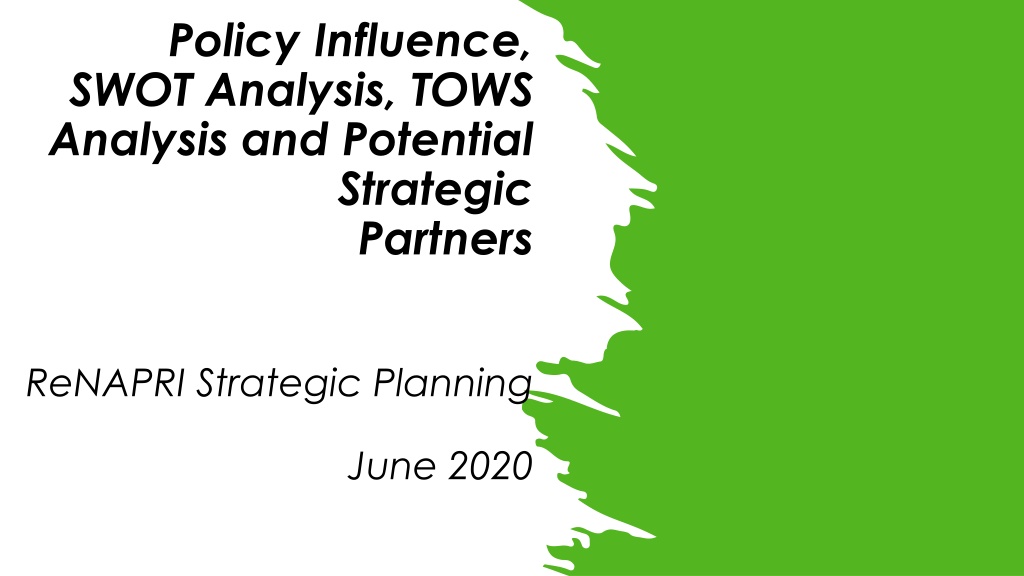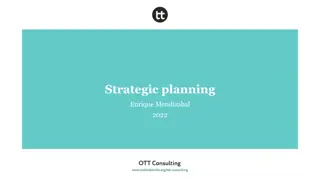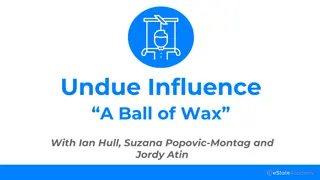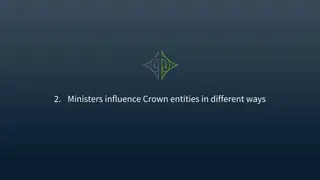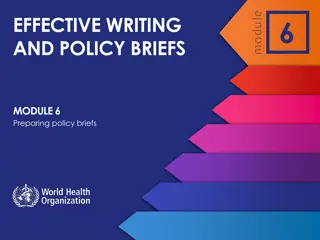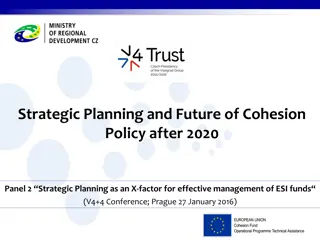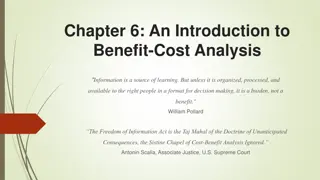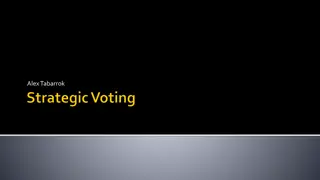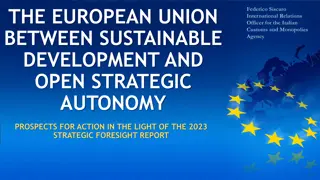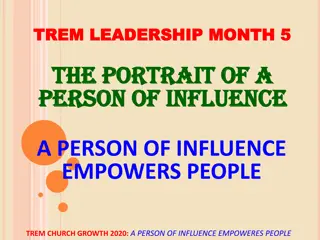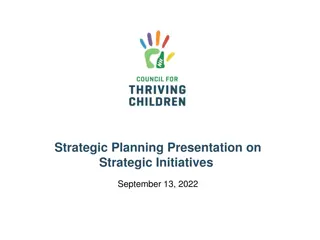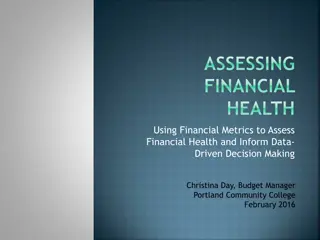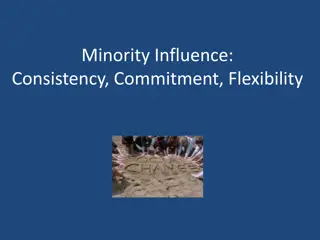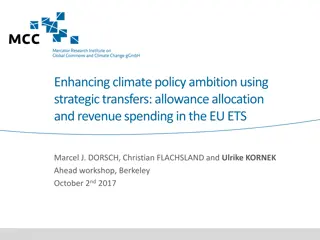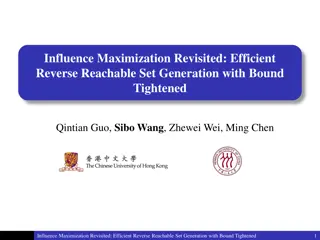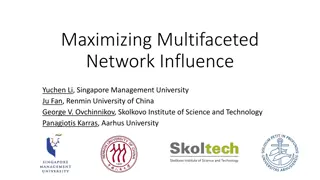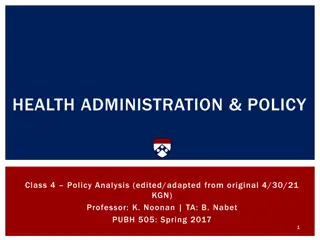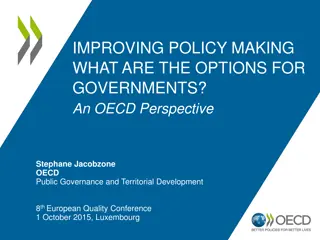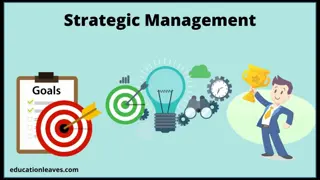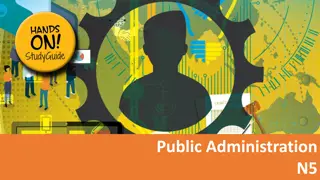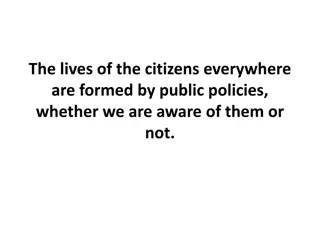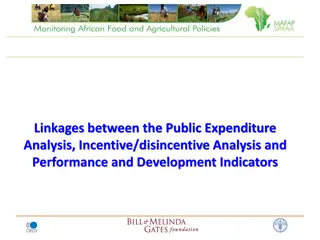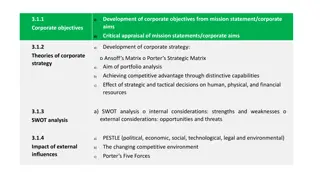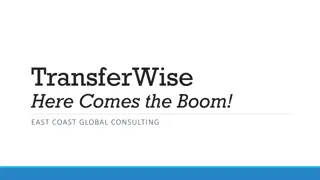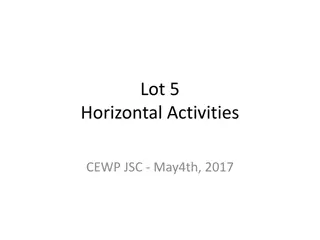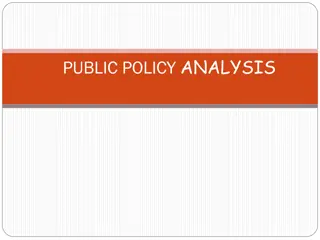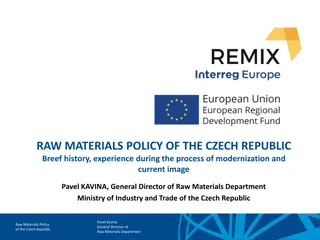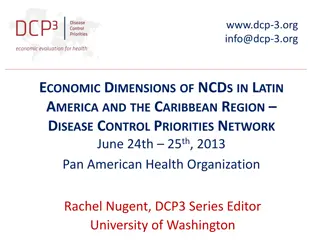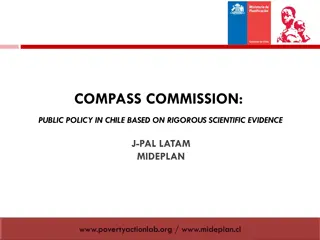Strategic Policy Influence and Analysis
Explore the definition of policy influence, its specifics, targeting levels, and SWOT analysis for strategic planning in June 2020. Understand the importance of shaping debates and issues to drive policy change effectively.
Download Presentation

Please find below an Image/Link to download the presentation.
The content on the website is provided AS IS for your information and personal use only. It may not be sold, licensed, or shared on other websites without obtaining consent from the author. Download presentation by click this link. If you encounter any issues during the download, it is possible that the publisher has removed the file from their server.
E N D
Presentation Transcript
Policy Influence, SWOT Analysis, TOWS Analysis and Potential Strategic Partners ReNAPRI Strategic Planning June 2020
Definition of Policy Influence (PI)
Definition of Policy Influence Specifics Tally Ranking Use of evidence on the part of policy makers 1,2,1,1,1,1,1,1 Change in Policy It is possible to establish attribution, in this definition of PI 2,1,4,3,2,3,2,2 Strong and regular media presence 2,2,4,2,4,2 Other (Specify) PI means; shaping the way that people in policy circles think about a particular policy issue, shaping the demand for policy analysis, Affiliation with strong lobbying groups, Implementation of policy recommendations, Adoption of the thinking, literature and language coming from policy research by policy makers 3,3,4,3
Definition of Policy Influence Specifics Tally Ranking Other (Specify) Under policy influence; It is generally difficult to say that a (particular) piece of analysis led to a change in policy because there are normally many interests and analyses that converge to result in a change in policy, Attribution to a specific study is generally difficult. Note that if many other researchers pick up on a study and conduct similar work on their own, which then eventually leads to policy change, it may be the initial work that indirectly contributed to policy change even if there were many other diverse pathways of policy impact. Therefore, shaping the debate and the issues are very important signs of policy influence.
What level of policy influence should ReNAPRI target ?
Relevant Level of Policy Influence Specifics Tally Ranking National 2, 3, 1,2, 3,3,1 Regional COMESA, SADC, SACAU, ECOWAS, AU, ECGC???, 1, 2, 2, 2,1, 2,2,2 Pan-African 3, 1, 1,3,1,1,2 Other National level is the domain of each of the national institutes, not so much the network, although the Network may indeed assist national institutes in meeting their national clients needs in some cases (where appropriate)
Strengths Diverse network of policy research institutes ensuring wider coverage at regional and Africa-wide levels. Diverse skilled, experienced, committed and highly qualified professional who provide room for expertise analyses and sharing (data, know-how etc) Committed Secretariat to support advancement of the ReNAPRI agenda in a more coordinated manner Value for one other, good teamwork, and common understanding, philosophy, training/schools of thought on policy among members Some member institutions with; strong national reputations strong technical capacity includes ex-ante and ex-post policy analysis strong institutional capacity strong national networks among public, private, and civil society groups strong national communication channels/platforms good funding effective databases Good tools such as - ReNAPRI Partial Equilibrium model, as well as policy modelling team and a good data base Virtual network which does not require brick & mortar structures to function. Grounded partner institutions with strong research output from member institutions, and significant research track records globally Potential influence in Pan-African organisations ReNAPRI Annual Stakeholder Conference and successful stakeholder engagements Effective network platform that allows for institutional collaboration Undertaken to answer food systems questions in a coordinated manner - critical to African countries, with potential to give ReNAPRI a competitive edge Strength in agriculture policy, particularly crops Respect for a number of member institutions - already accepted and consulted by policy makers. Interaction with the policy makers e.g. Pan-African Parliament
Weaknesses Different modus operandi for different research institutes making it difficult to harmonize the activities of ReNAPRI e.g.; Academic depts vs. independent/semi- autonomous institutes. Decision making is quicker for some institutions than for others red tape Most institutions are inward-looking in their operations, i.e. national issues, while ReNAPRI s focus is meant to be regional or pan-African. Varied capacities and competencies of different ReNAPRI members Others may seem more dominant, have more influence Difficult to have a realistically shared vision Country circumstances very different Need to build capacity technical, institutional and individuals No sustainable source of funding - relatively limited resources and operating budgets Poor capacity human resource and administrative coordination to manage the full task - Between Secretariat and individual member institutions Poor technical coordination and procedure for sharing data Under resourced On ad-hoc, project-related basis Lack a common code of engagement amongst our selves Absence of core research institutions from Ethiopia and Nigeria - these two countries have huge populations with food security imperatives Lack of a common research agenda Non-existent communication strategy and/or platforms Low visibility within country members Lack strong and legally empowered Secretariat to marshal network into speedy and decisive action The network engagement is currently too loose free entry and free exit
Opportunities There is high demand for evidence-based decision making. ReNAPRI is already well known and recognized by national governments, regional and pan-African bodies and other key stakeholders There is high demand for membership into ReNAPRI. ReNAPRI has individual and collective linkages (networks) with continental and global entities e.g. AfDB, WB, BMGF, IFPRI, SACAU Can leverage projects such as; MSU s GISIA project, IAPRI s FAO project in Zimbabwe, BFAP s BMGF and EU JRC projects. North-South connections with universities and centres of higher learning This provides opportunity to access learning/research materials Rapidly changing landscapes provide potential for insightful research to be impactful and to attract external funding. Emerging issues such as the current pandemic provides opportunity to undertake and present regional analysis on the effect of several policy options on the region s economic performance Agriculture is the mainstay of most countries in Africa ReNAPRI s main focus. Secretariat can undertake public relations and outreach activities e.g. COMESA, CARDESA, AU DREA & DTI, EAGC, PAP ReNAPRI can participate in matters relating to the African Continental Free Trade Area ReNAPRI has a preference for African Voices in shaping its future. Regional and pan-African organizations may wish to promote the development of African-led policy analysis units. ReNAPRI has global visibility and support from development partners There is opportunity to expand the network - more member countries will ensure greater presence in the continent. There is a push for an African renaissance and a search for policy solutions by African governments. This will assist in the acceptance and perceived relevance of ReNAPRI. Growing globalisation, increasing integration of African economies creates need for regional policies There is no African-based policy network that is currently active - ReNAPRI can fill this gap
Threats Presence of other similar policy research networks or international organisations, with more resources, may undermine the usefulness/relevance of ReNAPRI. Unwillingness of some key stakeholders to use ReNAPRI generated evidence. Change in political will or Instability in member countries in the region and Africa may negatively affect ReNAPRI s acceptability and influence Leadership changes in the member institutions may also negatively affect such member s commitment to the ReNAPRI cause. Some emerging issues such as COVID-19 pandemic and any other similar pandemics Some donors and development partners see ReNAPRI as having major capacity weaknesses, causing them to collaborate with other entities Lack of funding Lack of interest from policy makers Breakaways or breakups are always possible in partnerships involving different entities Some member institutions may lose interest Need to rise to expected levels to create traction and impact and to gain credence and acceptance as a regional network of reckon. Divergent objectives within the network members and international partners Individual institutions within the network may have their own local country agenda which may not align with the network s plan Willingness of institutions in the network to allocate time resources to activities of the network
ANALYSIS SUMMARY We have a strong platform which can potentially influence policy on the continent. In order that we do not leave some populations out of the drive, we will have to bring on board populous countries such as Nigeria and Ethiopia
Strengths + Opportunities Exchange visits Use annual conferences to present current, demanded, interesting and competitive work Use the annual stakeholders conference to communicate and share information Post-COVID world - moving towards increased virtual engagements. Mobilize individual capacities from the centers to work on aligned objectives Increase demand for evidence Take stock of existing skill in ReNAPRI List of researchers and specialization Make this available to the centers (e.g. via website) Employ a request for expertise form on website Strengthen value for one another Bring on board new members from Nigeria and Ethiopia Integrate CPEEL into the ReNAPRI network. Develop a robust communication tool that captures the evidence and converts it into accessible information for policy makers. Cross-fertilization Increase capacity jointly and using one other s strengths Assess internal capacity of the network. Support join research across the centers (already occurring) Strengthen inter-center exchange and collaboration - BFAP, Tegemeo, SUA Carry out joint research-join proposal writing and bidding Strengthen ReNAPRI s networks through the evidence that is produced Participate in forums where this evidence is being discussed. Leverage the annual conference to develop stronger networks Engage them not just during the sessions. Make a deliberate effort to engage them one on one. Perhaps side meetings with the leadership during the conference and after the conference.
Strengths +Threats Joint projects among centers to deal with inward looking activities Twinning institutions to help build capacity(strong institutions with strong capacity to support institutions needing capacity) Launch a Skills sharing platform Partner with ReSAKSS (potential threat) in post CAADP NAIP s implementation process. Use of PE model to project all relevant Value Chains ReNAPRI can use its unique modelling tools (market itself as a leader in this area) to counter the threats of other policy centers Develop direct relationships with researchers Host on-line forums for researchers periodically Sensitize members within the institution viz: what ReNAPRI has to offer. Regarding perception of weak capacity Inter-institutional capacity building Showcase the growth of capacities across the network. Develop strong relationships through the sense of family. Welcome new leaders as transitions occur. Develop relationships more broadly than with just the director and research director Quickly reaches out and onboard new leadership when transitions occur. Work with outgoing leaders to make sure that the linkages are successfully transitioned to the new leadership. Encourage team formation within the institutions so that there are equally informed members within the institutes Encourage Centre directors to delegate ReNAPRI responsibilities to other members of their team. Emphasize the uniquely African nature of ReNAPRI More partnerships with the likes of EAGC. Establish strong linkages with ReSAKSS, Ruforum, and others
Weaknesses + Opportunities Resources- in future consider some subscription fee given the high demand for membership into ReNAPRI To enhance regional strengths: encourage joint research projects between centers, cumulatively this can feed regional/African level Visit one another s the centers and meet with top leadership at each center to strengthening relationships and network. Ensure that each center has linkages to the ReNAPRI website so that the work of each center is captured and vice versa Develop a common research agenda that can be disseminated at the regional and continental level Ensure that the outcomes of stakeholder meetings are shared with political leaders and policy makers. Invite key policy makers to stakeholder meetings. Meet with policy makers after stakeholder meetings to share results of meetings. Diversify funding Seek more sustainable sources of funding. Meet with key donors to make increase knowledge of ReNAPRI s existence Support the Secretariat in diversifying funding sources.
Weaknesses + Threats Enhance human resources capacity at Secretariat to enable better administration and collaboration Develop an interactive website which centers can have access to and upload evidence and knowledge products - This will also enable better communication among centers Develop a very clearly delineated action plan that will allow ReNAPRI to respond quickly and efficiently to requests from East African (and pan African) institutions. Example, meeting with AU. Answer the question; What is ReNAPRI s comparative advantage? E.g. What are you doing that RESAKS is not doing?
POTENTIAL STRATEGIC PARTNERS
East Africa PUBLIC PRIVATE DONOR/DEVELOPMENT PARTNER OTHER International NGOs Pan African Parliament RECs - COMESA (1) - East African Community (2) African Union Member governments Ministries Eastern Africa Grain Council Banks According to region - AfDB (1) - World Bank Telecommunication companies - MTN - Airtel Media World Bank BMGF European Union DFID IDRC USAID FAO UNDP WFP IFPRI CGIAR Trade organizations Farmers federations Universities Ruforum AGRA
Southern Africa DONOR/DEVELOPMENT PARTNER PUBLIC PRIVATE OTHER *Pan African Parliament AU Commission (Departments) AUDA - NEPAD COMESA** SADC National Governments* Banks ABSA Bank* RMB UBA Bank Ecobank Private Sector EAGC ETG Mobile Phone companies* Agri-business Associations - AgBiz - WinPro USAID* DFID AfDB* EU: JRC* GIZ BMGF** UN Agencies (3 Rome Based Agencies FAO* WFP IFAD) ITC RESAKSS* AGRA** EAFF SACAU* CCARDESA* Universities* FANRPAN - - - - - - - -
